#Pnyx Hill
Explore tagged Tumblr posts
Text
hi! is there any attraction/place in Athens that you would highly recommend visiting? Maybe, hidden gems, or underrated places that are awesome? :') i apologize if this is a popular question that you get haha
Hello @dandelionesa ! You would be surprised at how little I know about Athens. I have been few times in my life there, despite being a native Greek living in the country all my life. I mean, I have lived there for a month once but I didn't explore at all beyond the neighborhood. So, I can tell you all the significant places not to miss but I lack the personal insight in little known gems.
Another thing about the blog is that if you visit from the browser, I have an option called "The Regions" which is essentially a travel guide about all main locations in Greece. It is not complete yet but the Athens one is. You can find it in: The Regions > Sterea Hellas > Attica for feature references. But, here, I am gonna screenshot the sightseeing recs mentioned there.
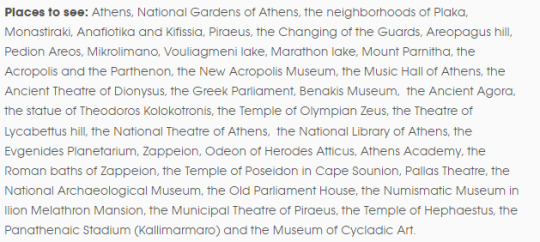
These are about Attica, the region that encompasses Athens. Most attractions are naturally inside Athens but there are some important ones like the Vouliagmeni Lake and the Temple of Poseidon that include driving / travelling outside the city.
The list is concise so I don't explain what each of these places is but they are worth visiting if you have the time. Of course, to do a proper journey of Athens, where Athens is going to be your focus, that takes time. It is a large place. Most people stay in Athens for two days before going to the main part of their vacation, usually some islands. You can't say you did Athens in two days though. Whoever says that to you, don't believe them. You can do Acropolis and like two-three museums at most in this time.
Apart from the ones above I also found some recs from other websites about hidden gems:
Philopappos Hill (that's not a hidden gem, I just forgot it in my own list lol)
Hellenic Motor Museum
Pnyx
Museum of the Basil & Elise Goulandris Foundation
Museum of Greek Folk Musical Instruments
Ilias Lalaounis Jewellery Museum
Benakis Museum of Islamic Art (NOTE: this is a different museum than the main Benakis one which I mention in the list above, if you can do both great, but if you can only do one, then the main must absolutely not be missed)
First Cemetery of Athens (yep, it's a valid rec)
National Observatory of Athens
Watch open air cinema in Thiseion. Or in the rooftop of Cine Paris.
The Greek National Opera (Ethnikí Lyrikí Skiní)
The Nautical Museum on the cruiser Averof
The Benakis (another Benakis) Toy Museum
I don't know what's wrong with me and I forgot to mention above:
Kapnikarea Church
The Metropolitan Cathedral of Athens
The UNESCO Monastery of Daphne
The New National Library (Stavros Niarchos Foundation). The one I mention in the first list is the Old National Library. Both are worth a visit for different reasons.
Go to Glyfada and along the Vouliagmeni coast for swimming (Vouliagmeni is a lake right next to the sea beach)
The Orthodox Church of Saint Dionysius of Areopagus

The Catholic Church of Saint Dionysius of Areopagus!

I was sleeping on the fact that there were two churches of those!
As you see I also added some recs for experiences i.e cinemas, theatres and so on. These are if you take your time in Athens, explore or stay for a while. Note that some might be less available in the summer, for example in summer the National Opera operates in open air performances like in the ancient Odeon of Herodes Atticus. If you stay and explore, check for concerts in theatres and stadiums. Concerts in Greece are real nice and vibey.
In retrospect, thanks for sending this ask because I realised I have a shitload of editing to do in my original list.
EDIT!!! The Byzantine and Christian Museum of Athens!!!! Srsly what's wrong with me lol
EDIT 2!!! Kotsaná Museum of Ancient Greek Technology!!! :@@@
#greece#europe#travel#guide#travel guide#tourist guide#athens#attica#sterea hellas#central greece#mainland#greek facts#dandelionesa#ask
35 notes
·
View notes
Text
Athenian democracy was different from the much later American form, not only because it was the expression of a single city-state but because it was a direct, rather than a representative, democracy. To us, looking backwards, it may seem imprudent to invite on all major initiatives, but Solon was right to appreciate that no Athenian freeman could allow himself to be let out of anything.
The continual buzz of conversation, the orotund sounds of the orators, the shrill shouts from the symposia – this steady drumbeat of opinion, controversy, and conflict could everywhere be heard. The agora (marketplace) was not just a daily display of fish and farm goods; it was an everyday market of ideas, the place citizens used as if it were their daily newspaper, complete with salacious headlines, breaking news, columns, and editorials. For more formal occasions, there nested beside the Acropolis the hill of the Pnyx, where thousands of citizens voted in their Assembly. They faced the bēma (speaker's platform) and, behind the speaker, the ever-changing backdrop of Athens itself. Though there were wooden benches, set into the steps of the hill, participants were too taken up by the proceedings to bother to sit down. The word the Athenians used for their Assembly was Ekklēsia, the same word used in the New Testament for Church (and it is the greatest philological irony in all of Western history that this word, which connoted equal participation in all deliberations by all members, came to designate a kind of self-perpetuating, self-protective Spartan gerousia – which would have seemed patent nonsense to Greek-speaking Christians of New Testament times, who believed themselves to be equal members of their Assembly).
Ten thousand men could be accommodated comfortably, fifteen thousand umcomfortably, on the Pnyx, where the Assembly convened forty times a year, each meeting lasting but a couple of hours. Six thousand citizens constituted the quorum necessary for ratification of many of the decrees. Imagine many of your fellow citizens – at least twenty percent of them, sometimes as many as fifty percent – squeezing forty times a year into an open-air stadium, listening to debates, noisily electing magistrates (including the ten stratēgoi chosen annually to conduct the city's wars), voting on decrees by a show of hands, impaneling jurors. On each of the popular courts, called dicastēria, 201 to 501 citizens served as both judges and jurors, the number of citizens depending on the seriousness of the matter under consideration. Once a year, the citizens voted on whether or not they should hold an ostracism. If the majority voted yes, each member of the Assembly then wrote on an ostrakon (potsherd) the name of the person he felt the city could do best without. Whoever turned up on the most ostraka was banished for ten years, after which time he could return, his property still intact. In this way, would-be tyrants – and not a few other nuisances – were eliminated. (If at first the primitiveness of this procedure shocks you, consider for a moment what benefits it could bring to your city.)
Athens, the world's first attempt at democracy – a Greek word meaning “rule by the people” – still stands out as the most wildly participatory government in history. Never again would such a broadly based, decidedly nonrepresentative model be attempted. And, given the compactness of Athens, the theatrical extroversion of its citizenry, and the consequent excitement of their meetings, it worked.
— Sailing the Wine-Dark Sea: Why the Greeks Matter (Thomas Cahill)
#book quotes#thomas cahill#sailing the wine-dark sea: why the greeks matter#history#classics#politics#law#ancient greece#athens#acropolis#pnyx#ecclesia#ostracism#solon
3 notes
·
View notes
Text

I had an little vacation in Athens last week.
The national observatory on The Pnyx hill, in the foreground the Agia Marina church.
2 notes
·
View notes
Text
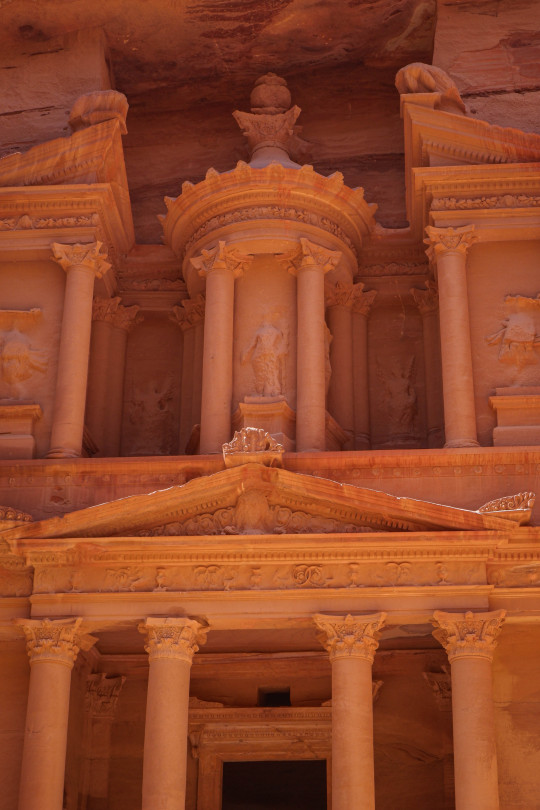
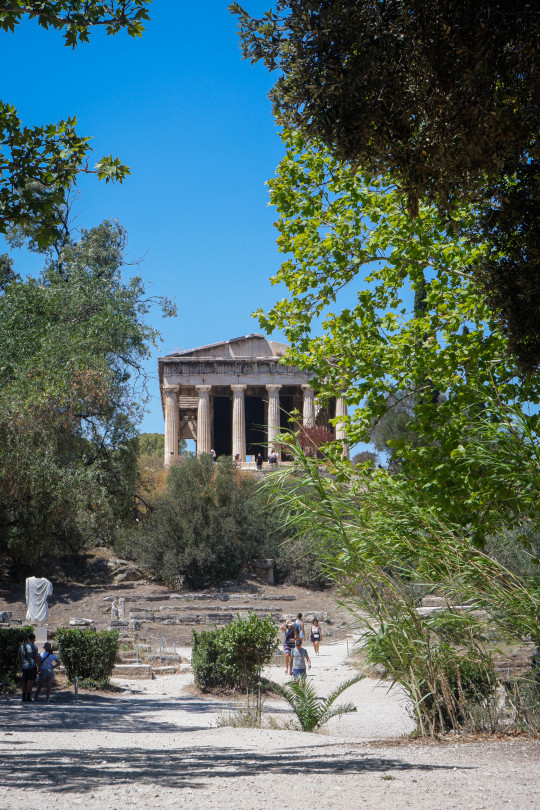
Greek Islands, Cyprus, Jordan & France - Full Itinerary
This summer I made one of my life goals come true and travelled for 3 weeks to 5 countries (the 4 I was meant to visit originally + an accidental stopover in Austria) including Greek mainland and island hopping as well as visiting one of the 7 Wonders of the World, Petra in Jordan.


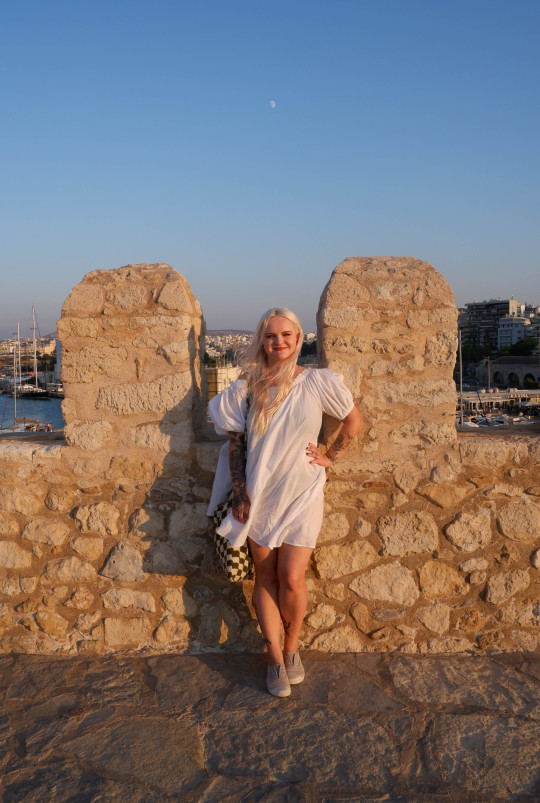
ATHENS - GREECE
Official gov tourism website https://www.visitgreece.gr/mainland/attica/athens/
Day 1
Take a 40 min bus from the airport
Temple of Olympian Zeus - Acropolis & Slopes Pass
Hadrian’s Arch - FREE
Theatre of Dionysus - Pass
Ruins of Asklepieion and Stoa of Eumenes - Pass
Odeon of Herodes Atticus - Pass
Acropolis of Athens - Pass
Erechtheoin - Pass
Temple of Athene Nike - Pass
Parthenon - Pass
Acropolis Museum - €15
Coming down the hill Areios Lagos (ancient law court) - FREE
Ancient Agora of Athens - Pass
Temple of Hephaestus (at the ancient agora) - Pass
Monastiraki Square - FREE
Hadrian’s Library - Pass
Day 2
Plaka - FREE
Zappeion Garden - FREE
Ethnikos Kipos (Athens national garden) - FREE
Kalamaki Beach - FREE
Day 3
The Prison of Socrates - FREE
Church of Saint Demetrios Loumbardiaris - FREE
Pnyx - FREE
Philopappou Hill - FREE
Flight from Athens to Santorini
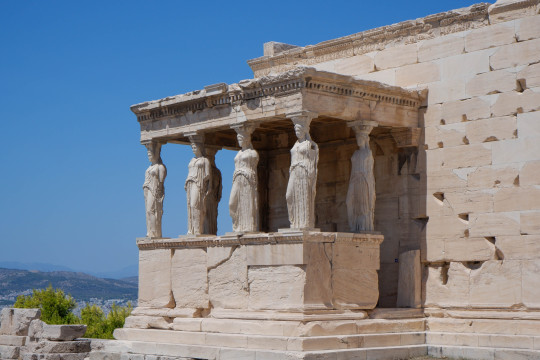
SANTORINI - GREECE
Day 1
Thera (Fira) day out - 30 min bus (€2)
Three Bells of Fira - FREE
Black sand beach - FREE
Day 2
Day trip to Oia
Day 3
Ancient Fira - £5
Ferry to Heraklion

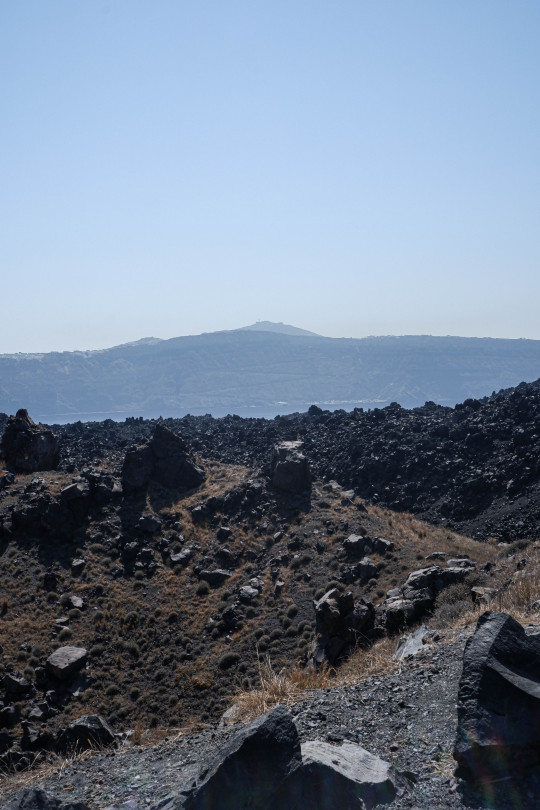
HERAKLION - GREECE
Day 1
Beach day - FREE
Day 2
Venetian port Heraklion - FREE
Old Town - FREE
Day 3
Knossos Palace - £15
Heraklion Archaeological Museum - Included in the ticket
Day 4
Take the bus to Chania, 2 hours 30 min https://www.allincrete.com/buses-timetables/ around £15
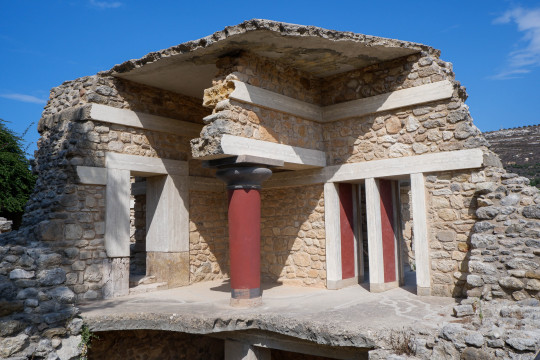
CHANIA - GREECE
Day 1
Old Venetian Port of Chania - FREE
Lighthouse of Chania - FREE
Boat Trip - many depart daily from the port for £25
Day 2
Chania International Airport flight to Paphos
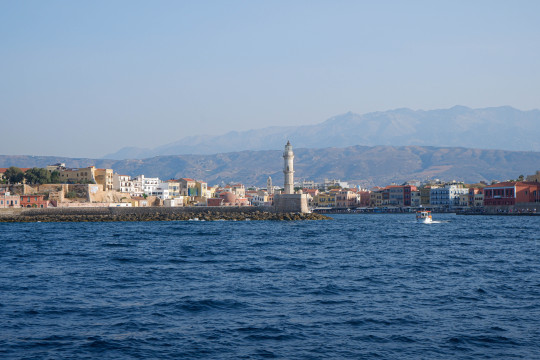
PAPHOS - CYPRUS
Day 1
Take a 25 min taxi to the hotel
Explore Paphos Old Town - FREE
Day 2
- Venus Beach - FREE
Day 3
Archaeological Site of the Tombs of the Kings - £2
Day 4
Archaeological Site of Nea Paphos - £4
Paphos Castle - FREE
Forty Columns Fortress - PAID
Paphos Mosaics - PAID
House of Dionysus - PAID
Villa of Theseus - PAID
House of Orpheus - PAID
Agora - PAID
Lighthouse - FREE
Day 5
Flight to Amman Queen Alia International Airport
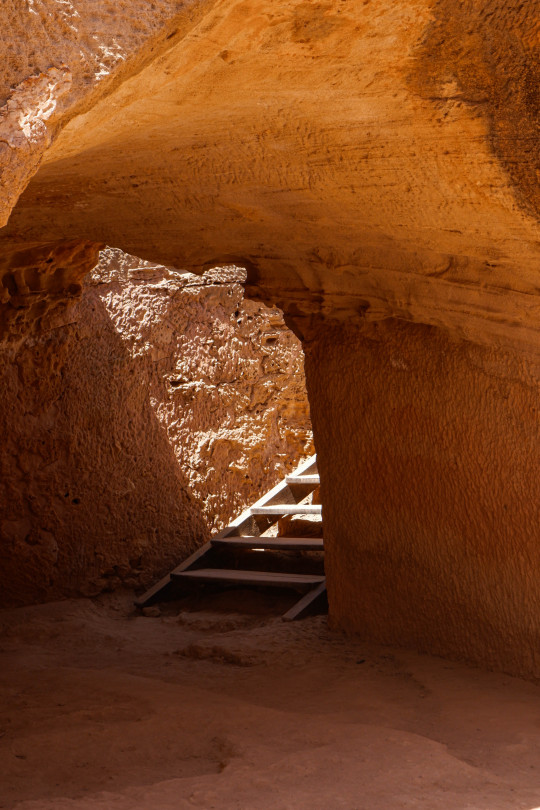
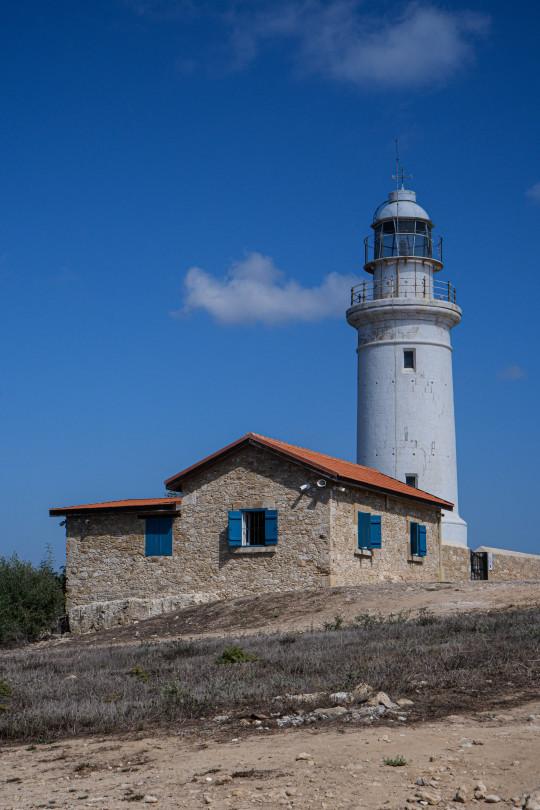
AMMAN - JORDAN
Day 1
Take a bus from the airport (departs every 30 min)
Roman Theatre - JORDAN PASS
Folklore Museum - JORDAN PASS
Amman Citadel: Open Cistern, Palace - JORDAN PASS
King Abdullah I Mosque - FREE
Rainbow Street - FREE
JORDAN PASS (includes visa) https://jordanpass.jo/Contents/Prices.aspx
Day 2
Take a bus from Amman to Petra 6:30 am takes 3 hours arrival 9:30 am https://www.jett.com.jo/en

PETRA - JORDAN
Day 2
Petra Tourist Office - FREE
Petra Museum - included in the JORDAN PASS
Siq (the Treasury) trail, then Jabal Haroun trail, then the climb up 900 steps Ad-Dier Monastery Hike - JORDAN PASS
Take a 40 JOD taxi to Wadi Rum Visitor Centre
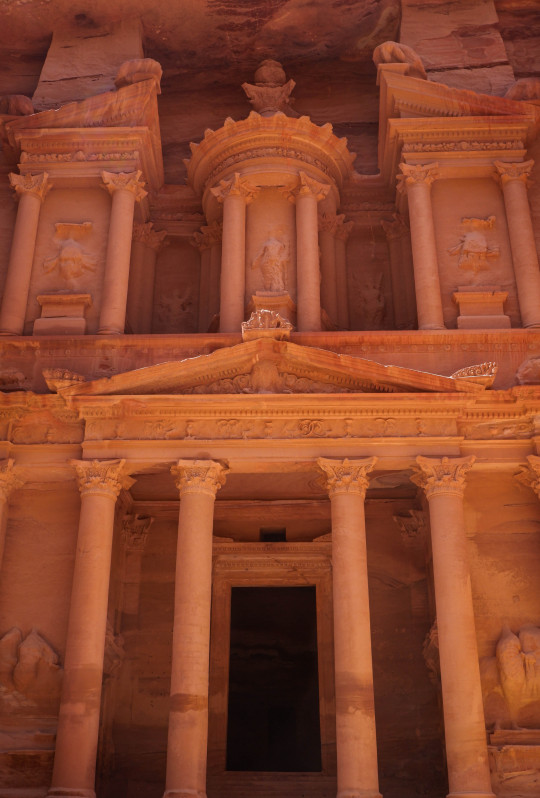
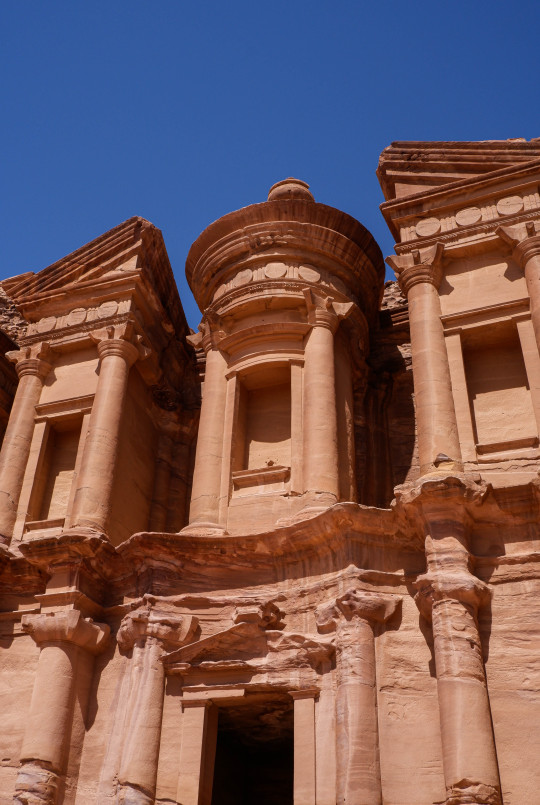
WADI RUM - JORDAN
Day 2 Continued
Pick up from Wadi Rum Visitor Centre for 5 JOD organised by the camp (let them know arrival time one day prior to the stay)
Check-in at Desert Magic Camp & Resort Ad Disah Road 1, 77110 Wadi Rum, Jordan
Traditional dinner - 13 JOD
Day 3
Jeep tour of the desert (regular 4 hours) - 22 JOD
5 JOD jeep ride back to Wadi Rum Visitor Centre
Take a bus back to Amman

AMMAN - JORDAN
Day 3 Continued
Dinner at Hashem Restaurant
Day 4
Swim in the Dead Sea - Amman Beach - Dead Sea - FREE or ask your hotel for a private driver around 80 JOD for two people with access to a private beach at one of the resorts
The Baptism Site of Jesus Christ https://www.baptismsite.com/operating-hours-a-entrance-fees/ - 12 JOD
Flight to Paphos then flight to France Marseille Provence Airport

MARSEILLE - FRANCE
Day 1
Chateau d’If via boat - €6 transport not included
Day 2
Palais Longchamp - FREE
Cathedral La Major - FREE
Basilica of Notre-Dame of la Garde - FREE
Flight from Marseille Provence Airport back to the UK
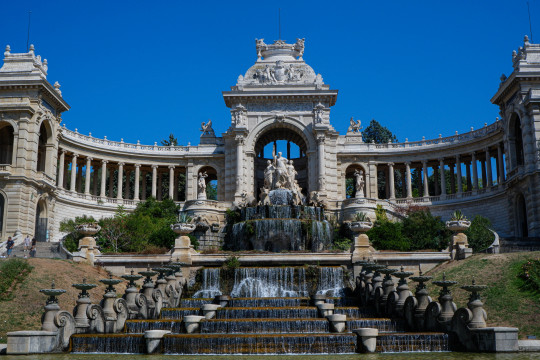
#travel#travel journal#travel diary#journal#travel plan#travel itinerary#travelphotography#photograpy#memories#traveling#travel photography
4 notes
·
View notes
Text
The Pnyx: where democracy was born, with the best views over Athens.
Would you like to visit the symbolic birthplace of democracy? Want the best views over Athens, including the Acropolis? Then talk a walk up the Pnyx hill, and you’ll be instantly immersed in a world of ancient history and incredible landscapes.
#goexploregreece#greece#travel#mustsee#mustvisit#beautiful views#athens#holiday#europe#athens city#travel guide#wanderlust#traveling#tourism#hills#kites#exploregreece#explore#adventure
2 notes
·
View notes
Text

The Hill of the Nymphs and the National Observatory of Athens from the Pnyx on July 10, 2019.Greece
Opening:28 June 1842
Photo by George E. Koronaios
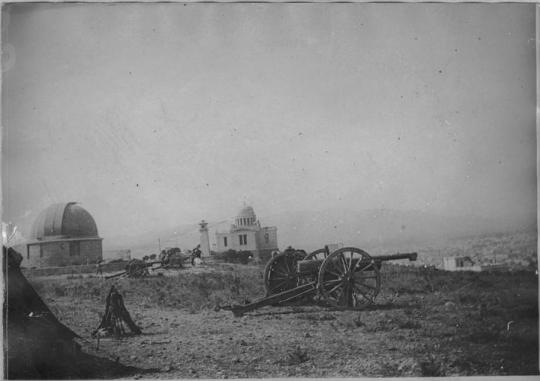
Athens Observatory,26 June 1917
(Artlllery during the short period of French occupation of Peireus and Athens,World War I)
Source:Médiathèque de l'architecture et du patrimoine
#Athens#Greece#Hill of the Nymphs#National Observatory of Athens#astronomical observatory#photography#science#old#architecture#history#old photo#time#World War I#allies#black and white#strategy
2 notes
·
View notes
Text
Last Day in Greece - Athens, Greece
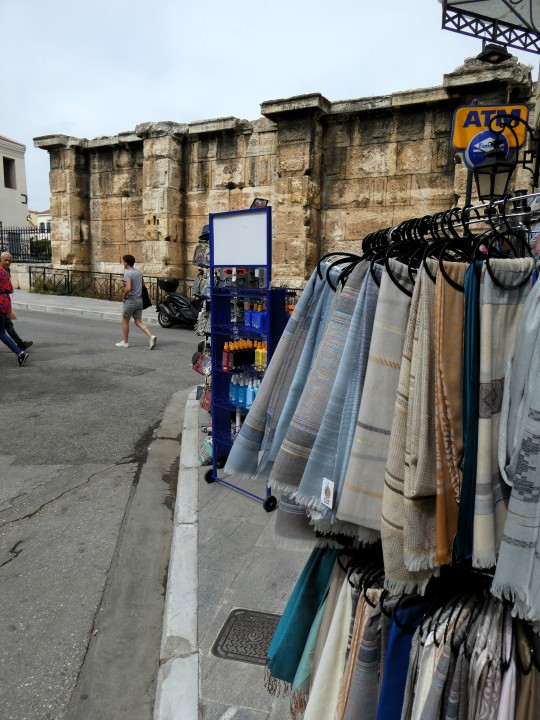
Originally, the plan for today was to check out the flea market, then climb the Hill of Muses, and go to Takis Bakery to buy bread for dinner. We successfully completed all of those tasks, but the things we came across unexpectedly along the way were wonderful little gems. What a great last day in Athens!
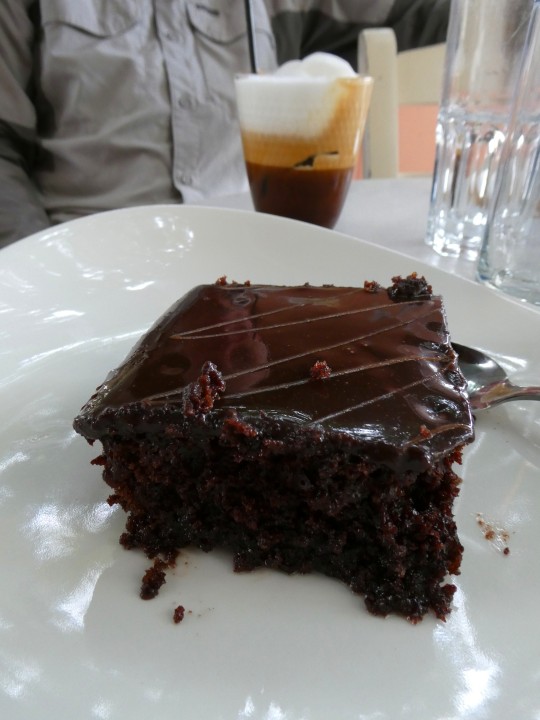
After checking out a couple of shops, we decided we needed a little bite to eat. We found a little street cafe, hoping for a little lunch - unfortunately, they weren’t serving lunch, yet. So we had an iced cappuccino and a chocolate “pie” (looked like cake to us) - both were amazing and we had enough fuel on board to continue with our mission for the day!
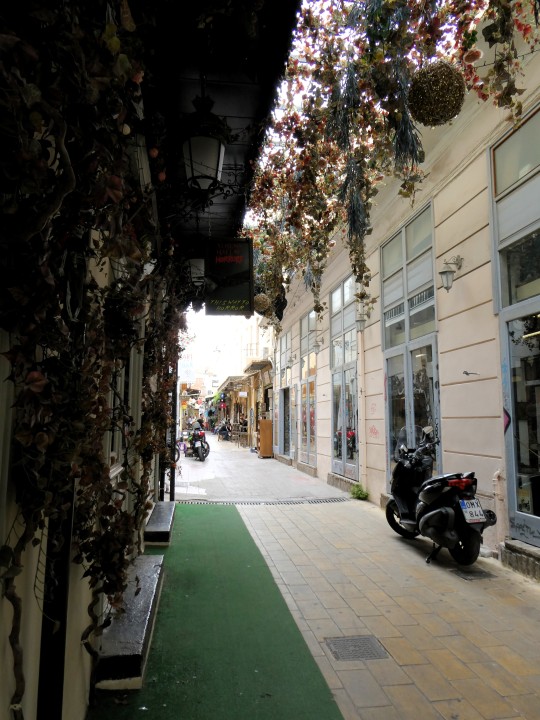
One of the streets near the flea market.

Think we found the flea market!

We wandered the streets near the Stoa of Attalos, there was a museum inside, but we decided to just walk outside.
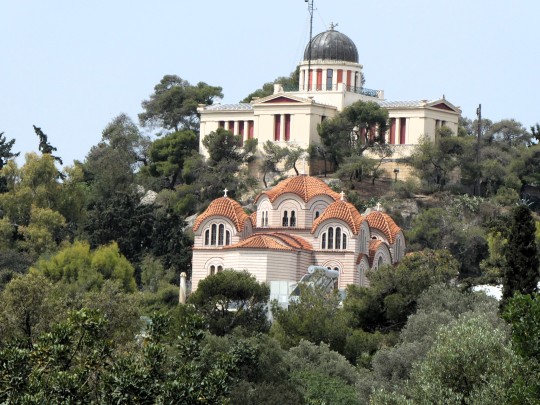
We could see the National Observatory and a beautiful church in the distance while we were walking.
Once we left the flea market area, we found ourselves on a huge pedestrian walkway to the west of the Acropolis. We followed it around, lots of vendors and restaurants, but nothing that really appealed to us. We came across this interesting wooden bike on one of the sidewalks:

As we were walking along, we looked up one of the side streets and saw the church that we had seen from the stoa. We decided to head up the street and check it out.

We couldn’t read the name of the church, it was in Greek. However, we enjoyed walking around the beautiful building.


Jacaranda tree in the plaza next to the church.

Behind the church, we found this walkway/road, we took it up to the entrance of the National Observatory. The Observatory was closed, so we couldn’t go in.

National Observatory.

From the observatory, we followed a set of stairs up the hill. We found ourselves on a pathway that led to ruins - cool surprise!
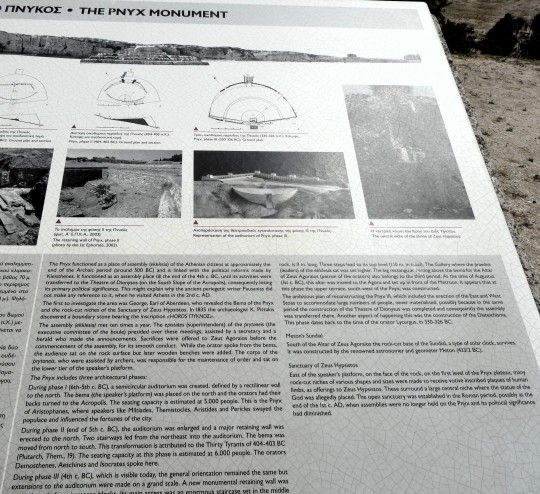
The Pnyx Monument, built between the late 6th century BC to the late 4th century BC. It served as a meeting place, holding around 10,000 people in the open-air chamber.

Speaker’s platform - Aristides, Pericles, Demosthenes, and Themistocles all delivered speeches here.

Niche in the wall where there was a statue of Zeus Hypsistos, the smaller cuts in the rocks held candles.
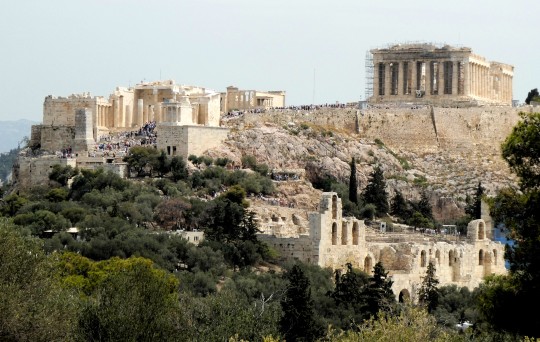
Spectacular view of the Acropolis from the Pnyx Monument.

Lycabettus Hill in the distance.

As we continued along the path, hoping to eventually find the path up to the Hill of the Muses, we came across this beautiful church. Church of Ayios Demetrios Loubardiaris.

A few people were ringing these bells, while we walked around the church.

The patterns in the walls were amazing - I am sure that they were indicative of something, but we didn’t see information about that.

This emblem was carved into the side of the roof of the church.

One of many carvings on the side of the church.
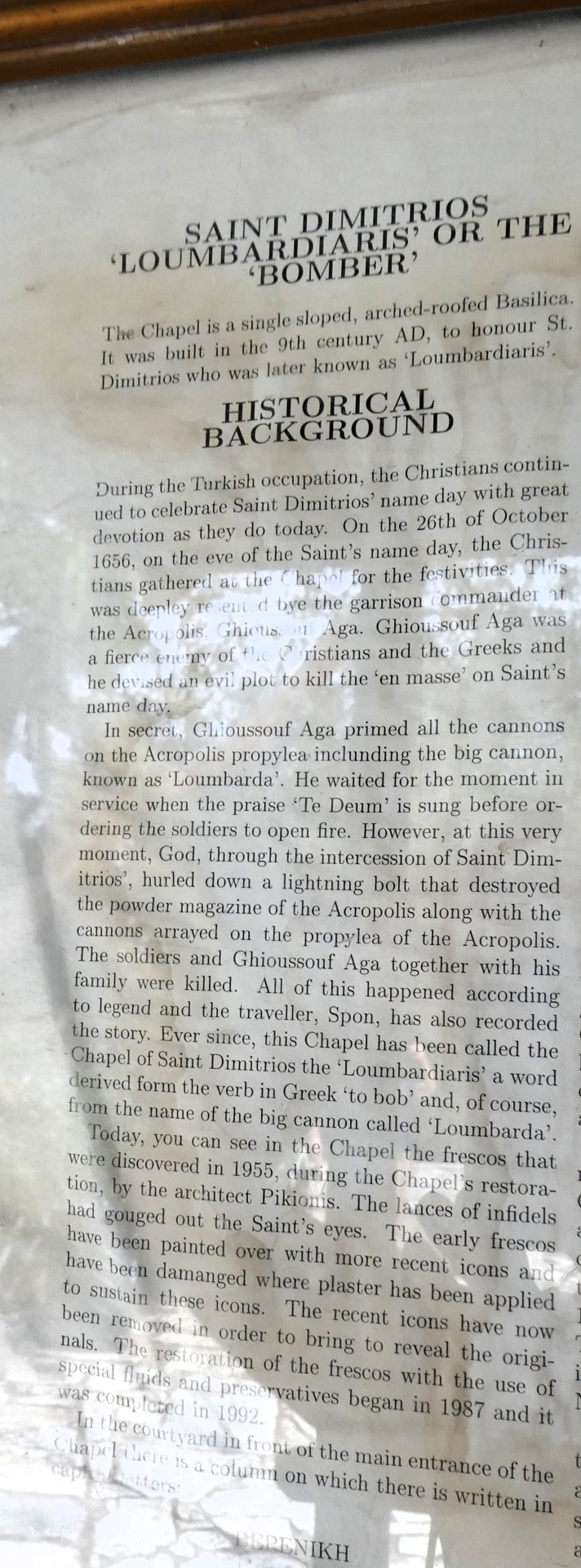
Great story about the church.

Sign at the bottom of the path heading up the Hill of Muses.
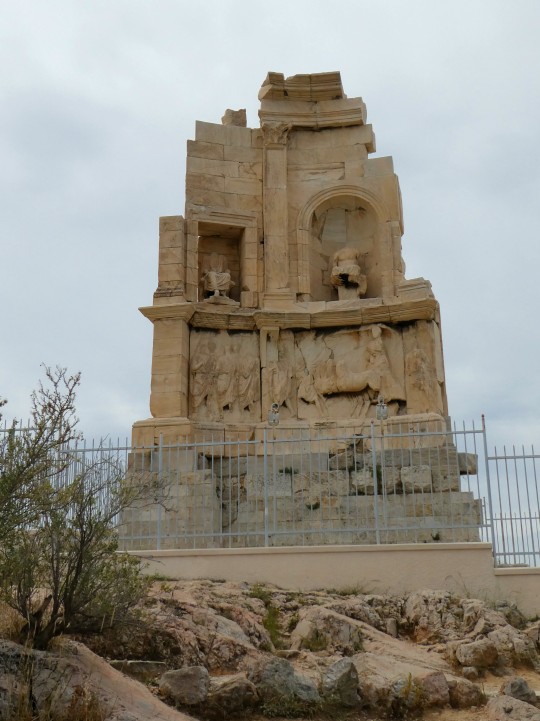
Philopappos Monument located at the top of the Hill of Muses (also known as Philopappos Hill).

Info about the Hill of Muses.
On our way back to our place, we stopped at Takis Bakery for a loaf of bread. It was very crowded and very tiny - I forgot to take pictures due to the tight quarters. We also found a great little deli, where we stopped and bought cheese and salami to go with our bread.

Doug, trying to decide what kind of salami he wanted for dinner.
We dropped off our purchases at our apartment and then walked a couple of blocks to a sidewalk cafe for lunch. I had a great Greek salad, Doug had a slice of pizza and some of my salad - we were entertained by the crazy, chaotic streets of Athens as we ate our lunch on the sidewalk.
I wanted to get a couple of pictures that would demonstrate the amazing parking skills of the people of Athens - it is really quite remarkable where and how people find places to put their cars and scooters:



The street to our apartment in Athens.

After lunch, we walked over to a bar close to our apartment and had a couple of adult beverages. We enjoyed visiting with the bartender - he is headed to New Hampshire in December to visit a friend. We shared with him how cold it was going to be during his visit, I don’t think he believed us! It was fun having a chance to learn a little about Athens from him, he was very disappointed that we did not get to visit any of the Greek islands. Maybe next time!
We took a little siesta after lunch, taking the time to just hang out at our apartment and catch up on some blogging and other business we needed to handle. We had a dinner of bread, cheese, salami, and fruit on our patio. As the sun was setting, we wandered out again to find a place to spend our last evening in Greece.
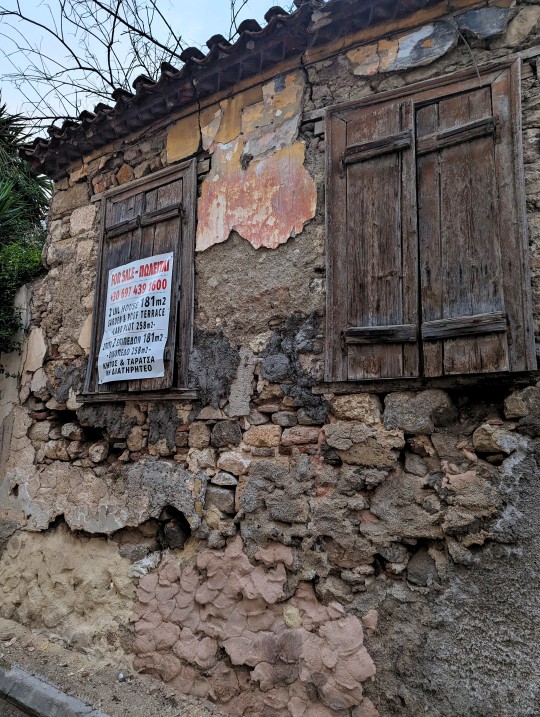
While wandering the Plaka neighborhood, we found this little fixer-upper for sale.

Beautiful streets of Plaka.
While wandering the streets, I noticed a sign over a doorway that indicated a rooftop bar. We walked into the lobby of the building and climbed several flights of stairs, before we found a little doorway that opened to a little restaurant and bar area. We decided to walk through the small indoor space to the patio at the back of the building. We found ourselves to be the only people that wanted to sit outside. We walked outside and found ourselves staring at this scene:
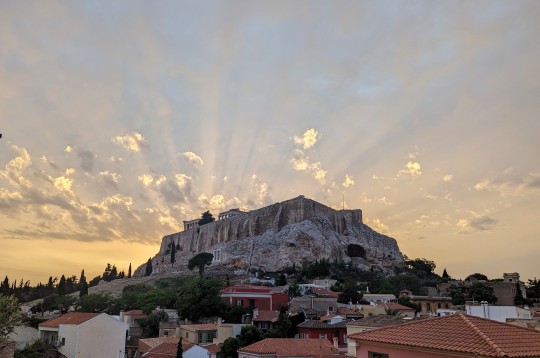
Jaw-dropping view of the Acropolis from the rooftop of this hotel.

We ordered ouzo, since we hadn’t had any during our visit to Athens.

Oh, we also had a glass of wine, too!
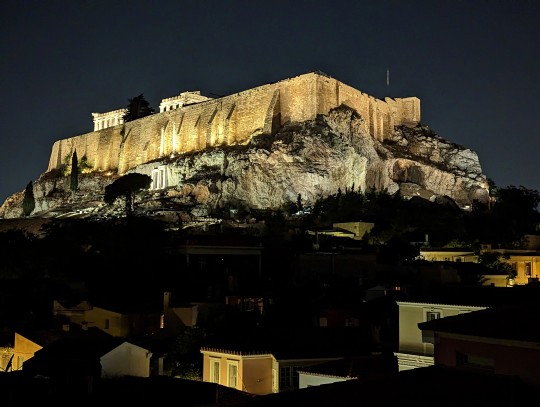
Our view only improved as the city lights came on.

Great little find - Hotel Byron Roof Garden.

On our way back to our apartment, we noticed this little wine bar - just a block from our apartment. We had to check it out!
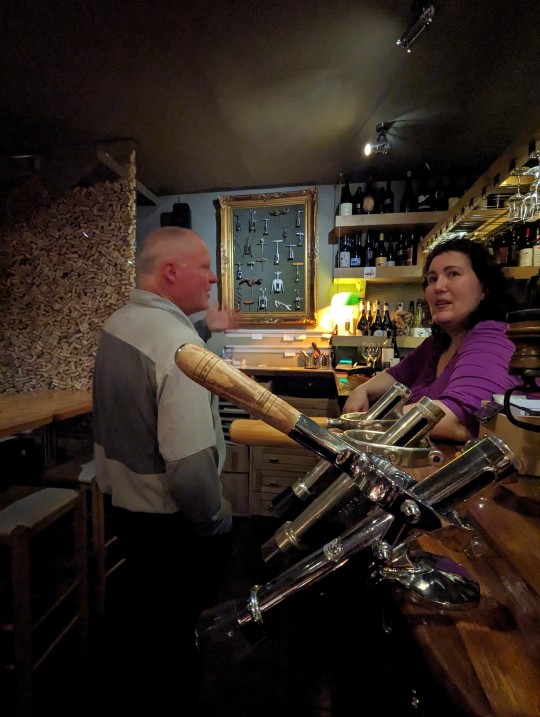
Doug, talking wine-openers with one of the owners of the wine bar.

Jamas, from Wine Pointe in Athens!
2 notes
·
View notes
Text
Premium Photo Tour of Athens' Hidden Gems
Unveiling Athens' Best-Kept Secrets 1. Anafiotika Anafiotika is a hidden gem nestled in the shadows of the Acropolis. This picturesque area of Athens feels like a traditional Greek village, with narrow alleyways, whitewashed buildings, and colorful flowers in bloom. Its unique atmosphere is a perfect backdrop for taking stunning photographs. 2. The National Garden The National Garden is a peaceful oasis in the center of Athens. It is a perfect place to escape the hustle and bustle of the city and get lost in nature. With its beautiful flowers, shady trees, and small lakes, it is a photographer's paradise. Wildlife enthusiasts can spot turtles, ducks, and even peacocks roaming around the garden. 3. Mount Lycabettus For breathtaking panoramic views of Athens, head to Mount Lycabettus. You can either hike up the hill or take a funicular to reach the top. Once you reach the peak, you'll be rewarded with an incredible view of the city's skyline. It's an ideal spot to capture stunning sunset and nighttime photographs. 4. The Ancient Agora The Ancient Agora is a glimpse into Athens' rich history. This archaeological site is home to ancient temples, public buildings, and marketplaces that date back to 6th century BC. The site also features a museum that showcases artifacts from the ancient Athenian life. It's perfect for history buffs and photographers interested in capturing ancient architecture. 5. Psyrri Psyrri is a trendy neighborhood that's quickly gaining popularity in Athens. Its narrow streets are lined with classic and modern cafes, restaurants, and bars that offer a mix of Greek and international cuisine. The vibrant street art and colorful buildings make it an excellent location for capturing the essence of modern Athens. 6. Monastiraki Flea Market The Monastiraki Flea Market is a bustling market that sells a wide range of souvenirs, antiques, and second-hand goods. The vendors' colorful stalls and the market's lively atmosphere are ideal for capturing vibrant street photographs. You can also enjoy a cup of traditional Greek coffee while browsing the market. Explore these hidden gems in Athens with our premium photo tour, and capture unforgettable memories to last a lifetime. An Overview of Athens' Hidden Gems Athens, the capital of Greece, is famous for its ancient ruins, museums, and souvlaki. But did you know that there are plenty of hidden gems in Athens that are off the tourist radar? If you're tired of the typical tourist hotspots, check out these lesser-known places. The Pnyx Located just below the Acropolis, the Pnyx is a hill where the ancient Athenians gathered to address political issues. The Pnyx is an excellent spot to enjoy stunning views of the city and the Acropolis. It's also a peaceful escape from the bustling tourist sites nearby. The Anafiotika neighborhood Nestled beneath the Acropolis is the charming neighborhood of Anafiotika. This neighborhood was built by workers from the island of Anafi in the 19th century and has a distinct Cycladic architecture. The narrow alleys and white-washed houses make it an idyllic place to explore. The National Garden The National Garden is a hidden oasis in the heart of Athens. Located behind the Greek Parliament, it's a peaceful retreat from the busy city streets. The garden features a small zoo, a pond with ducks and turtles, and many places to relax and enjoy nature. The Monastiraki Flea Market While the Monastiraki Flea Market is not entirely hidden, it's often overlooked by tourists in favor of the more famous markets in Athens. Here, you can find a treasure trove of antique items, vintage clothing, and unique souvenirs. It's a great place to get lost and explore the winding streets filled with shops and restaurants. The Stavros Niarchos Foundation Cultural Center If you're interested in contemporary art and architecture, the Stavros Niarchos Foundation Cultural Center is a must-visit. The building houses two of Greece's most prominent cultural institutions, the National Library and the National Opera. The center also includes a park with stunning views of the sea and the city skyline. The Byzantine and Christian Museum The Byzantine and Christian Museum is often overlooked by visitors in favor of the more famous museums in Athens. However, this museum is home to an impressive collection of Byzantine and post-Byzantine art and artifacts, including icons, mosaics, and frescoes. In conclusion, Athens has many hidden gems just waiting to be explored. From the Pnyx to the Monastiraki Flea Market, there's something for everyone. So the next time you're in Athens, be sure to venture off the beaten path and discover these lesser-known treasures. Capturing the Charm of Anafiotika One of Athens' hidden gems is the picturesque neighborhood of Anafiotika. This charming area is located in the Plaka district, just below the Acropolis. It was built in the 19th century by workers from the Aegean island of Anafi who came to Athens to work on the construction of King Otto's palace. The Colors and Architecture The charm of Anafiotika lies in its narrow cobblestone streets, its traditional Cycladic architecture, and its colorful houses with blue doors and shutters. The houses are built without any plan or order, giving the neighborhood a unique and organic vibe. The white walls and blue accents offer an endless supply of photo opportunities. The narrow alleys provide a fantastic backdrop for portraits or shots of architectural details. The Views The neighborhood's elevated location, just below the Acropolis, offers stunning views of the ancient city and its landmarks. From Anafiotika, you can see the Parthenon, the Erechtheion, and the Theater of Dionysus in all their glory. The views from the neighborhood are unbeatable, especially at sunrise or sunset when the light hits the marble temples at an angle, creating a warm and magical atmosphere. The People and Lifestyle Anafiotika is a small community that still maintains many of the traditions and ways of life from the Aegean island of Anafi. The locals are friendly and welcoming, and it's not uncommon to see them sitting outside their houses, chatting or playing backgammon. The neighborhood has a relaxed and laid-back vibe, making it a perfect spot to take a break from the hustle and bustle of central Athens. All of these factors contribute to the neighborhood's magic and make it a delightful place to visit and photograph. Discovering the Serenity of Philopappos Hill If you're a history lover or just enjoy getting away from the hustle and bustle of the city, Philopappos Hill is a must-see hidden gem in Athens. This lush park is home to one of Athens' most important ancient monuments, the Philopappos Monument, which honors a famous citizen of ancient Athens. Finding your way to Philopappos Hill The best way to get to Philopappos Hill is to take the metro to Petralona station and then take a leisurely 20-minute walk through charming neighborhoods to the hill. On your way to the hill, make sure to stop at the quaint cafes and enjoy the picturesque streets of Athens. What to See and Do Once you arrive at the park, start your climb up the hill, and take in the stunning views of the Acropolis, the Parthenon, and the Athens City Center. On your way up, you'll run across many historical monuments and views you won't want to miss. The Philopappos Monument is a magnificent landmark worth exploring as it is one of the well-preserved ancient monuments in Athens. As you explore this beautiful park, don't forget to marvel at the many outdoor art exhibitions and sculptures. Benefits of Visiting Philopappos Hill One of the main advantages of visiting Philopappos Hill is that it is an idyllic escape where you can enjoy nature and appreciate Athens' historical breadth. As you hike up and down the hill, you'll soak up not just Greek history but also the sights of the modern city and the beauty of Athens. All in all, Philopappos Hill is a perfect escape from the crowds and noise yet still offers a glimpse into Greek culture and history. It's a must-visit if you're planning a trip to Athens! Exploring the Riches of Agora Located in the heart of Athens, Agora is a bustling market filled with shops, restaurants, and vendors selling a variety of goods. It's a lively and exciting destination that's perfect for any visitor looking for an authentic Greek experience. Shopping in Agora One of the biggest draws of Agora is the shopping. From traditional Greek souvenirs like pottery and jewelry to modern clothing and electronics, you'll find something for everyone here. Make sure to haggle with the vendors to get the best price! Food and Drink Of course, no trip to Agora would be complete without trying some of the delicious Greek food and drink on offer. From fresh seafood to mouth-watering gyros, there's something for every palate. And don't forget to try some of the local wine! Historical Significance Agora also has a rich historical significance. It was the center of ancient Athens, where people gathered to discuss politics and trade goods. You can still see the remains of ancient buildings and temples as you explore the market. Overall, Agora is a vibrant and exciting destination that should definitely be on your list of places to visit in Athens. With its incredible shopping, delicious food, and historical significance, it's truly a hidden gem of the city. Basking in the Glory of the Panathenaic Stadium The Panathenaic Stadium, also known as Kallimarmaro, is a wonder of ancient Greek engineering and architecture. Built entirely out of marble, this stadium is located in Athens and has been the site of many historical events. From the ancient Greek Olympics to the modern Olympic Games, this stadium has seen it all. History of the Panathenaic Stadium The Panathenaic Stadium was built in 330 BC for the Panathenaic Games, a festival that honoured the goddess Athena. It was used for various events such as foot races, wrestling, and chariot races. The stadium was destroyed in the 2nd century AD and remained in ruins until it was rebuilt in the 19th century for the revival of the Olympic Games. What to Expect from a Visit When you visit the Panathenaic Stadium, you will be able to walk through the entrance where the ancient athletes would have entered. You can also see the marble seating areas where spectators would have watched the events. The museum inside the stadium showcases the history of the stadium and the Olympic Games. Interesting Facts about the Panathenaic Stadium - The Panathenaic Stadium is the only stadium in the world built entirely out of marble. - The stadium can seat up to 60,000 spectators. - The modern Olympic Games were revived in this stadium in 1896. - It was also the site of the opening and closing ceremonies of the 2004 Athens Olympic Games. - The stadium was used as a concert venue for famous musicians such as Frank Sinatra, Bob Dylan, and Tina Turner. Visiting the Panathenaic Stadium is an amazing experience that allows you to step back in history and see one of the most impressive structures ever built. Don't forget to bring your camera to capture the breathtaking views of the stadium and the city of Athens. Savoring the Flavors of Athens' Hidden Foodie Spots Athens isn't just about the ancient temples and the picturesque neighborhoods; it's also a food lover's paradise. When visiting Athens, you have to make sure you try some of the local delicacies at the city's hidden foodie spots. From traditional Greek dishes to modern fusion cuisine, Athens has it all. Here are some of the best hidden foodie spots in Athens that you don't want to miss. 1. Karamanlidika tou Fani Karamanlidika tou Fani is a deli that serves artisanal cold cuts and cheeses, along with other delicious Greek products. The deli is tucked away in a narrow alley in the heart of Athens, and once you find it, you won't regret it. The meats and cheeses here are made from high-quality ingredients and are absolutely delicious, especially when paired with a glass of homemade tsipouro. 2. To Kafeneio To Kafeneio is a traditional Greek café that serves homemade dishes and pastries. The café is located in the artistic neighborhood of Psyrri, and the atmosphere here is cozy and intimate. You can try the spicy feta dip, the savory pies, and the refreshing lemonade, which are all made with fresh and locally sourced ingredients. 3. Cookoovaya Cookoovaya is a modern restaurant that serves creative Greek cuisine with a twist. The restaurant is located in the chic neighborhood of Kolonaki, and the décor here is contemporary and elegant. You can try the octopus with feta mousse, the pork belly with apple puree, and the tuna tartare with avocado and wasabi, which are all beautifully presented and bursting with flavor. 4. Ta Karamanlidika tou Fani Another hidden gem from the same family of Karamanlidika tou Fani, Ta Karamanlidika tou Fani is a taverna that serves traditional Greek dishes with a modern twist. The taverna is located in a beautiful neoclassical building in the central square of Monastiraki, and the atmosphere here is relaxed and convivial. You can try the fava bean puree with caramelized onions, the slow-cooked lamb with herbs, and the homemade baklava, which are all made with love and care. These are just a few of the hidden foodie spots in Athens that you can explore during your premium photo tour. Whether you're a food lover or just looking to try something new, Athens has something for everyone. If you're looking for an exquisite experience in wine tasting and photography, don't miss out on Snap and Sip - Premium Wine Tasting and Photography in Burgundy. Read the full article
0 notes
Text
What did you know about Pnyx?
What did you know about Pnyx?

With a great cultural heritage that makes it stand out from the rest, the capital of Greece offers millions of tourists the opportunity to learn about its history and traditions every year. With many places to see and stories to discover about each, Athens has never disappointed. When people choose Athens as their holiday destination, they know they will spend quality time, and still, all of them…
View On WordPress
0 notes
Photo





Pnyx (First democratic parliament in the world)
Athens, Greece
507 BCE
The Pnyx (Greek:Pnyka) is a hill in central Athens, the capital of Greece. Beginning as early as 507 BCE, the Athenians gathered on the Pnyx to host their popular assemblies, thus making the hill one of the earliest and most important sites in the creation of democracy.
The Pnyx was used for popular assemblies in Athens as early as 507 BCE, when the reforms of Cleisthenes transferred political power to the citizenry. It was then outside the city proper, but close enough to be convenient. It looks down on the ancient Agora, which was the commercial and social centre of the city. At this site all the great political struggles of Athens of the "Golden Age" were fought out. Pericles, Aristides and Alcibiades spoke here, within sight of the Parthenon, temple of Athena. Here Demosthenes delivered his vilifications of Philip II of Macedon.
The Pnyx was the official meeting place of the Athenian democratic assembly (Ancient Greek: ekklesia). In the earliest days of Athenian democracy (after the reforms of Kleisthenes in 508 BCE), the ekklesia met in the Agora. Sometime in the early 5th century, the meeting place was moved to a hill south and west of the Acropolis. This new meeting place came to be called "Pnyx" (from the Greek word meaning "tightly packed together".
In the early history of the Pnyx, three phases can be distinguished:
Pnyx I: Probably constructed in the early 5th century. The people apparently sat on the hillside facing a speaker's platform on the north. The seating capacity may have been anywhere from 6000 to 13,000 people. This phase is represented archaeologically only by a few cuttings in the bedrock and a boundary stone (not found in situ), so that it is impossible to determine the date and size with any precision.
Pnyx II: Probably late 5th century BCE In this phase the orientation of the auditorium was apparently reversed (a reconstruction that is based more upon ancient literary sources than from the actual archaeological record). A stepped terrace wall was created on the north to support an artificial terrace, and the people sat facing a speaker's platform on the south. Some sources stated that this retaining wall was constructed around 500 BC for the purpose of holding the soil that was brought in to form the level space for the bema. Part of the stepped terrace wall is preserved, as well as a staircase with rock-cut steps leading up to it from the direction of the Agora. The size of the auditorium (as it is restored by the excavators) is not that much larger than Pnyx I.
Pnyx III: The Pnyx was rebuilt and expanded in the 3rd quarter of the 4th century BCE, probably around 345-335 BCE A massive, curved, retaining wall was built (or at least begun) on the north. The southern side of the auditorium and speaker's platform (bema) were quarried out of the natural bedrock. (Traces of the quarrying process can still be seen at the eastern side of the great rock-cut scarp). On a terrace above (south of) the speaker's platform, the foundations were begun for 2 long stoas (but these seem never to have been finished). It is unknown for how many years Pnyx III was used as the meeting place of the ekklesia, and certainly by the 1st century BCE the assembly held their meetings in the Theater of Dionysos on the South Slope of the Acropolis.
Finally, in the Roman period, part of the Pnyx was used as a sanctuary of Zeus Hypsistos. Evidence for the sanctuary consist of c. 50 niches for votive plaques cut into the bedrock scarp east of the speaker's platform. Many of the votive plaques are carved with representations of human body parts (eyes, breasts, etc.), suggesting that this Zeus Hypsistos was a healing divinity.
Sources: 1, 2, 3
#art#Architecture#travel#history#bema#stage#ekklastarion#pnyx#athens#6 bce#5 bce#3 bce#greece#greek#greek art#Greek architecture#democracy
167 notes
·
View notes
Text
Some of my favourite places in Athens:
The Pnyx and the Philopapos hill. I honestly cannot express how lovely is it to walk around the muses hill and watch the sunset from it, besides, it has so many hidden historical gems inside.





The agora and the Roman agora. Especially the last one it is beautifully preserved and walking around you can almost see Romans passing by.


The keramikos. The museum is great and I liked it better than the archaeological. Besides seeing Themistocles walls was just... Wow.


And last but not least, the Lycabetus hill. The best view of Athens there will ever be. If you really don't like climbing up a really long stairway, take the cable car. Only seven euros and it departs every half an hour.

Some other tips I wanted to say:
If you are taking the train back to the airport there is a special train that leaves every half an hour and goes ON THE SAME RAILS as the normal line. So keep that in mind when you calculate timings.
If you're under 25 and from the EU museums and historical landmarks are free!
People are really friendly and speak English really good.
Try the spanakopitas and kouloris! Two very underappreciated delicious and very cheap dishes. Also try greek coffee! Strong but really worth it.
Do not miss the opportunity to go into any Byzantine chapel, the outsides are beautiful but the insides are marvelous.
I just came back and already want to go back! Now I get the whole Roma capta est!
3 notes
·
View notes
Photo










Greece blanketed by heaviest snowfall in over a decade February 16, 2021.
Greeks took to social media to post pictures and videos of the snow, a rare sight in the cities. Many ancient sites such as the Acropolis in Athens were also blanketed in snow.
Snow is common in Greece’s mountains and in the north of the country, but much rarer in the capital. Some Athenians emerged cautiously outside, snapping photos on balconies and in the streets.
Some children skipped online classes Tuesday to play in the snow. Adults also went out to play, with some digging out skis to use on the capital’s hilly slopes. One man skied along Pnyx hill in central Athens, near the Acropolis.
Norwegian Ambassador Frode Overland Andersen tweeted a video of himself skiing down a hill in the suburb of Filothei with his teenage daughter.
“Challenge accepted,” he wrote, after a friend in Oslo challenged him to prove it really was possible to ski in Athens.
“It was the best day at my home office during the lockdown so far,” the ambassador told The Associated Press. “Sadly, my skis took a rather hard beating, so I will be waxing and prepping for next season.”
Outside the parliament building, orange snowplows cleared streets of ice and snow, while presidential guards, dressed in traditional pleated kilts and pompom-tipped shoes, were given heavy woolen overcoats.
Daily inspiration. Discover more photos at http://justforbooks.tumblr.com
22 notes
·
View notes
Text
Hercules: Disney VS Mythology (1)
(Originally this was just a series of posts I made for friends but I thought why not turn it into a series of Tumblr posts for other people who might be interested? So here we go)
So… Everybody know the Disney movie Hercules, right ?
The 35th Disney animated feature film. The eighth movie of the Disney Renaissance. Disliked by the critics at first, considered a failure by the Disney staff, yet that slowly gained a good reputation and a strong fandom.
But not in Greece. Oh, boy, not in Greece. The Greek people HATE this movie – mostly remembered there as “foreigners taking our history and culture and distorting it for the sake of money”. You know, Disney planned to have a premiere of the movie in Greece, on the Pnyx hill (the main hill of Athens). The Greeks refused and manifested so that it wouldn’t happen. That’s how much the Greeks hate this movie.
And indeed, many people have pointed out and recognize that Hercules is actually without a doubt one of the worst adaptations of Greek mythology to exist. I am not talking about the quality of the movie itself, I am speaking of its role as an adaptation – and when the movie has barely anything to do with the original myth, you know it is a bad adaptation. The original plans for the movie were actually closer to the original legends – for example Hera was supposed to be the villain, not Hades. They took inspiration from some great names of Greek myths in America – Thomas Bullfinch, Edith Hamilton, Robert Graves… But they ultimately backed out because, one, they wanted to make a screwball comedy and so took off most of the tragic, dark or too bleak elements ; and two, they were Disney, they had family values, and so they refused to depict an illegitimate child as a hero. The writers told it themselves – Disney did not want to handle the topic of out-of-marriage kids, it did not want to have an illegitimate child as a protagonist, and so this is why they had to rewrite everything, find new villains, new origins, entirely new things.
So what I will do for this mini-series is that I will take the Disney movie and compare it to the actual legends and myths of Heracles, to see how exactly Disney invented an entirely new character.
Oh yes, I will begin now with already the most obvious mis-adaptation, the biggest trouble-point, the mistake Disney popularized into people’s culture and mass media.
WHY DID THEY CALL IT HERCULES? It is true that the character is today best known by this name, but it isn’t his original name. I mean it is not even a GREEK name. Hercules is the name the ROMANS gave to the character; it is the Roman version of the hero. The Greek hero is named Heracles (you can also write Herakles, known that “c” and “k” are basically the same).
So they literally just made an entire story set in Greece, about the Greek hero, surrounded by Greek mythology figures – BUT THEY GAVE HIM A LATIN NAME. Just because it is the name people are most familiar with.
2 notes
·
View notes
Text
VESPASIAN AND THE COW OF MYRON


The marble statue of a cow, found in the Horti Tauriani on the Esquiline Hill and now in the Capitoline Museum, is a Roman copy of the Cow of Myron. Admired for the austere, cerebral classicism of works like the Discobolus, and for his bronze centaurs, Myron cast the first bronze depiction in Greek art of an animal other than a horse around 480 BC. Displayed on the Pnyx in Athens, the bovine statue was hailed in antiquity as a masterpiece of mimesis (viewers attempted to pet it, etc). Myron’s cow was still attracting tourists in Athens in the 1st century BC.
Vespasian seems to have acquired the statue on his return journey to Rome from Judea. He placed the Cow on public view in the precinct of the Templum Pacis around A.D. 70. A vigorous promoter of Roman agriculture, Vespasian left the forecourt of the temple unpaved and allowed innoxious animals to graze among the shrubbery planted there. The real cows mingling with the famous brazen beast conferred prestige on the new dynasty’s agricultural initiatives.
The heifer served other political purposes as well. Vespasian had constructed the Templum Pacis on the site of Nero’s razed Domus Aurea, which had been built on illegally confiscated public land. Along with the Cow, he displayed equally famous sculptures from Nero’s vast personal collection, many of which had been acquired by coersion or theft. By donating both land and art to the public in the form of a gallery, Vespasian sought to distance himself from Nero and earn the approval of the Roman people.
Vespasian and Titus after him also bought the acquiescence of the less-cultured citizens by building the great amphitheatre. These benevolent acts of restitution helped to legitimate his place on the throne and the Flavian dynasty. The importance of the Cow at this critical moment in the history of Rome is confirmed by its appearance on the reverse of gold denarii minted under Vespasian.
The bronze cow was still on view in the 6th century, but lost sometime thereafter. The Capitoline marble copy, originally placed in the fabulous gardens of the consul Titus Statilius Taurus (sometime after his death), is the best record of the original’s appearance we have.
80 notes
·
View notes
Text
Who wants to meet on Pnyx hill in Athens to practice a primary form of democracy? I'll be there at four o'clock . Let's debate!
2 notes
·
View notes
Text

Filopappou Hill and the Acropolis of Athens as viewed from the Pnyx.
#greece#goexploregreece#travel#mustsee#mustvisit#greek#europe#beautiful views#athens#pnyx#Filopappou hill#athens city#incredible views#hills#relax#traveling
12 notes
·
View notes